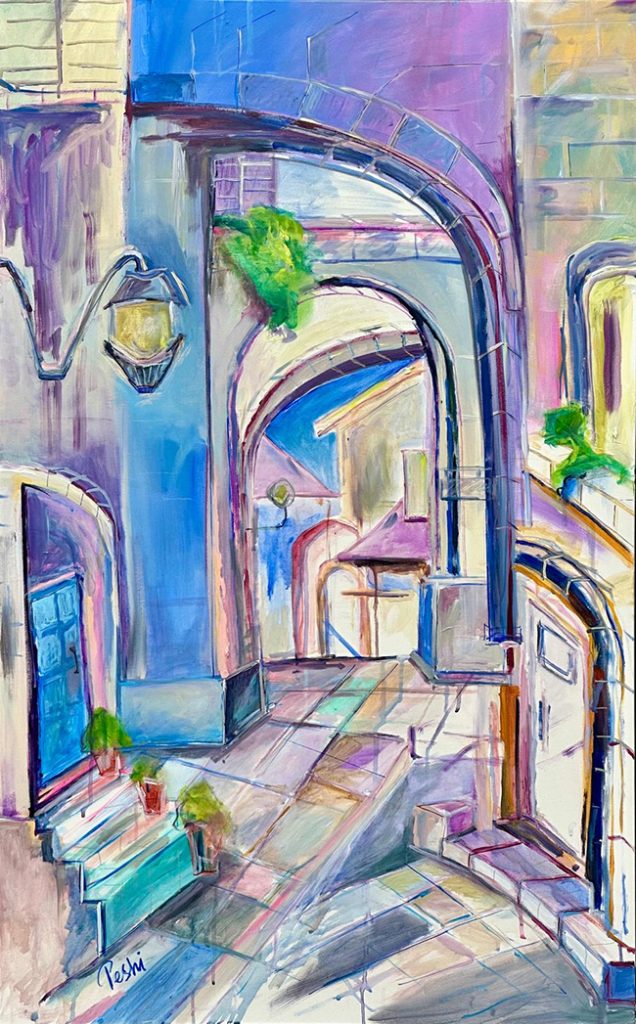Peshi Haas doesn’t follow trends—she follows alleys. Her art is grounded in the physical world but pulled through a lens of abstraction and intuition. A graduate of the School of Visual Arts (SVA), Haas has shaped her own lane in contemporary painting by blending architectural abstraction with elements of travel and urban exploration. Her work isn’t about replicating places; it’s about reimagining them.

What drives her isn’t just form or line—it’s the overlooked. Forgotten buildings, hidden courtyards, narrow paths that most tourists skip. She documents and transforms them, turning structural impressions into layered color, movement, and texture. Haas has spent years pulling meaning out of neglected corners of cities around the world, reshaping how viewers experience space, light, and composition. For Haas, architecture isn’t static—it’s something you walk through and feel.
In one of her most recent works, Peshi Haas dives deep into the rich textures and layered atmosphere of Jerusalem’s old city. But this isn’t a street view you’d find on a postcard or map. Her large-scale acrylic and oil stick painting brings forward the essence of a hidden alley—a place she encountered during her travels, then spent weeks translating into canvas.
The painting opens up with bold sweeps of yellow and deep purple. These complementary colors aren’t just decorative—they pulse with energy. Haas has always been drawn to color as a means of storytelling, and here it works like a compass. Yellow creates warmth and light. Purple grounds the shadows and lends a sense of quiet mystery. Together, they give the piece its pulse.
The scene unfolds through movement. Cobblestones are sketched into the foreground, forming an abstract path that draws the eye inward. “I like the viewer to end up in the center via the streets,” Haas explains. She doesn’t build her paintings around a single focal point but instead guides the viewer, pulling them forward through layered lines, arches, and fragmented shapes. Nothing is fully rendered, yet everything feels familiar.
Awnings stretch across the top of the piece, creating a sense of enclosure—like walking through a shaded lane at midday. Their shadows are not just dark patches but textured brushwork that gives the surface rhythm. There’s a sense of depth in the layering. Shapes bleed into one another, mimicking the overlapping histories of ancient places.
Though this work is inspired by Jerusalem, Haas didn’t stop with what she saw. She extended the visual narrative—adding more archways, imaginary streets, and recurring motifs like lanterns and city thresholds. These are symbols she’s carried through her work for over 25 years. Each one holds a memory or a visual rhythm she’s learned to trust. The piece becomes less about a specific location and more about the experience of wandering, discovering, and reinterpreting.
Haas describes herself as a travel artist, but her style is not about quick impressions or exoticism. She immerses herself in the locations she paints, often sketching onsite or walking the same street repeatedly before starting. She treats the city like a collaborator. Its textures, sounds, and surfaces seep into the work long before the first brushstroke hits.
What sets Haas apart is her ability to balance structure and fluidity. Her compositions are clearly rooted in architecture, but they aren’t rigid. There’s motion in the way she draws walls. Energy in the negative space. This particular work manages to feel both grounded and dreamlike, rooted in stone but alive with improvisation.
Over time, she has developed a visual language that works like a map of her travels—except the streets shift, the cities blend, and the destination is less important than the path itself. Her art doesn’t capture monuments or landmarks. It focuses on what’s easily missed: the play of shadow on stone, the curve of an alley, the feeling of being small inside a massive, layered world.
In this piece, that philosophy is clear. It’s not a portrait of Jerusalem. It’s a memory turned inside out, layered with color, rebuilt with imagination. And like much of Haas’s work, it invites the viewer to slow down, wander a little, and maybe take a new path through something old.


